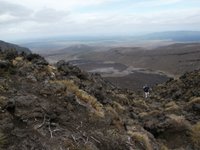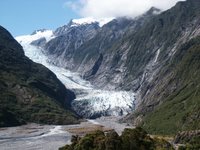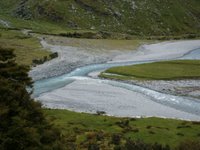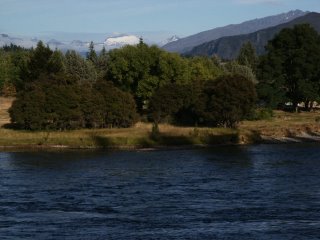

Our final destination: Abel Tasman National Park. One of the finest sea kayaking spots in the world. (Stop #7 on
the map.)
Now on day 7, we woke in Nelson to rain. Not good, but we only had a 1-hour drive to get to the park to arrange things for kayaking the next day, so we headed to late morning wine tasting (Nelson being one of the main wine-producing areas in NZ), and lunch. If you're ever there, The Grape Place is excellent. They've got a couple of wineries' tasting rooms, some cool art, and most importantly, we had a first-rate lunch there. Put us in a fine mood, despite the rain.
We departed after lunch, and right then the sun broke through! We did the beach on Rabbit Island for about 2 hours, then headed to Motueka to resupply food, and made one final stopover on the beach in Kaiteriteri. The pictures seen here are from Kaiteriteri, which is just 7km east of the Park. It was sunny, and the lagoon there (no word on how much the little white house will go for), promised great things. Abel Tasman is basically just an extended series of ocean-front lagoons, which you explore via kayak or on water taxi. We were excited for a two-day excursion on sea, ending with about 4 hours of hiking, through this paradise.
We got to Marahau, the gateway to the Park, that afternoon. Still remarkably sunny.
Then the first hiccup arrived. We'd originally planned on this being our
first stop on the whole trip, but rain caused us to move it to the end and do our whole trip backwards. The upshot was that I missed that the change meant that to do our whole kayak/hike, we'd miss our ferry back to Wellington. So we had to cut it back and miss the hike at the end, the outfitters explained to us. But no worries, it would still be a great trip. We made camp, excited about the excursion, and had an early night.
The next morning was cloudy. When we arrived at the kayak-rental place, they told us the winds would get up to 30 knots that day, and they strongly recommended that beginners like us not attempt it. That scared us (we didn't want to drift to Antarctica), so we made a decision: we'd do our training that morning, spend the day merely backpacking about 3 miles in, and then return to pick up kayaks for only a one-day-er the next day. That would cost us some dough, but we wanted a good experience. This seemed like a particularly sage decision during the actual on-the-sea portion of our training. The winds, at a mere 10 knots, were causing us problems, and we were clearly unskilled, so backpacking seemed like the wise choice.
So we packed our bags (with way too much stuff), and that afternoon set out for our short, 1.5 hour hike along the coastline. Again, it was beautiful. Then we got to our beach camp. Nice beach. 15 minutes later the rain started. We tucked ourselves under a tree, hoping to wait it out. 2 hours of rain later, we were screwed. Our bags and our bodies were soaked. We hate camping in the rain, let along soaking in a downpour from which your gear cannot recover, so we made a bold choice: we'd hike out. We were bummed, but then the hike back through what was now a complete mud-river and full-on downpour carrying waterlogged packs converted that into pure unhappiness.
We promptly gave up on the sea kayaking. A total bust. We got a 50% refund and decided to head to nearby Motueka for the night, to find some shelter and give up our vow to not get another motel. After warming up on some yummy Indian food and finding comfort in a drink, we searched for a place to stay. The rain had fully booked the town, so we decided to drive the hour back to Nelson. The drive was awful--pitch black, sheeting rain, high winds, lots of hydroplaning on very winding roads, low visibility. This was the worst rainstorm I've ever seen, and I grew up in Oregon and endured tornado season in Memphis. We didn't want to stay in Nelson again, but we decided to try to find a place there simply because there was no other option. But now it was 11pm, and it turns out that most of the motels in NZ close their doors at 10pm. After fruitlessly searching several places, we finally stumbled upon the best one yet. It had a spa bath in the room, cable TV, and a dehumidifier to dry out our clothes (some of which might not recover, it seems).
So that was a nice ending to what was a very disappointing day. The kayaking, Abel Tasman, the sunny beaches, all never really materialized, except what you see in the pictures here. What a tease.




















































